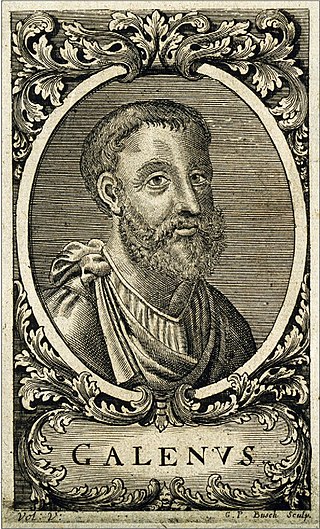
Aelius Galenus or Claudius Galenus, often anglicized as Galen or Galen of Pergamon, was a Roman Greek physician, surgeon and philosopher. Considered to be one of the most accomplished of all medical researchers of antiquity, Galen influenced the development of various scientific disciplines, including anatomy, physiology, pathology, pharmacology, and neurology, as well as philosophy and logic.
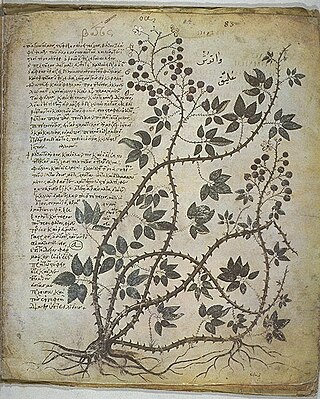
Materia medica is a Latin term from the history of pharmacy for the body of collected knowledge about the therapeutic properties of any substance used for healing. The term derives from the title of a work by the Ancient Greek physician Pedanius Dioscorides in the 1st century AD, De materia medica, 'On medical material'.
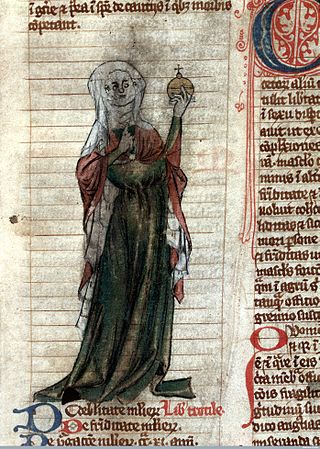
Trotula is a name referring to a group of three texts on women's medicine that were composed in the southern Italian port town of Salerno in the 12th century. The name derives from a historic female figure, Trota of Salerno, a physician and medical writer who was associated with one of the three texts. However, "Trotula" came to be understood as a real person in the Middle Ages and because the so-called Trotula texts circulated widely throughout medieval Europe, from Spain to Poland, and Sicily to Ireland, "Trotula" has historic importance in "her" own right.

In the Middle Ages, the medicine of Western Europe was composed of a mixture of existing ideas from antiquity. In the Early Middle Ages, following the fall of the Western Roman Empire, standard medical knowledge was based chiefly upon surviving Greek and Roman texts, preserved in monasteries and elsewhere. Medieval medicine is widely misunderstood, thought of as a uniform attitude composed of placing hopes in the church and God to heal all sicknesses, while sickness itself exists as a product of destiny, sin, and astral influences as physical causes. On the other hand, medieval medicine, especially in the second half of the medieval period, became a formal body of theoretical knowledge and was institutionalized in the universities. Medieval medicine attributed illnesses, and disease, not to sinful behaviour, but to natural causes, and sin was connected to illness only in a more general sense of the view that disease manifested in humanity as a result of its fallen state from God. Medieval medicine also recognized that illnesses spread from person to person, that certain lifestyles may cause ill health, and some people have a greater predisposition towards bad health than others.
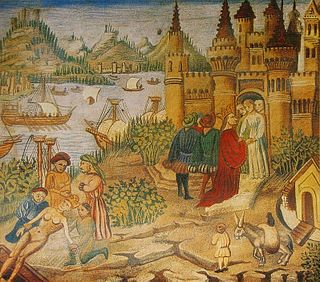
The Schola Medica Salernitana was a medieval medical school, the first and most important of its kind. Situated on the Tyrrhenian Sea in the south Italian city of Salerno, it was founded in the 9th century and rose to prominence in the 10th century, becoming the most important source of medical knowledge in Western Europe at the time.

Hunayn ibn Ishaq al-Ibadi (Arabic: أبو زيد حنين بن إسحاق العبادي; ʾAbū Zayd Ḥunayn ibn ʾIsḥāq al-ʿIbādī was an influential Arab Nestorian Christian translator, scholar, physician, and scientist. During the apex of the Islamic Abbasid era, he worked with a group of translators, among whom were Abū 'Uthmān al-Dimashqi, Ibn Mūsā al-Nawbakhti, and Thābit ibn Qurra, to translate books of philosophy and classical Greek and Persian texts into Arabic and Syriac.
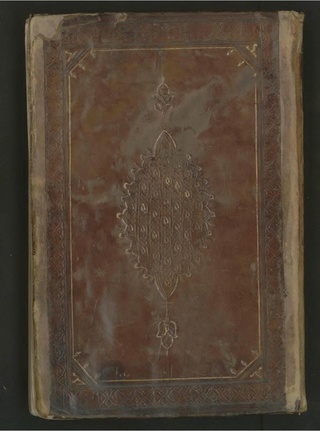
Ibn Abi Sadiq al-Naishaburi, Abu al-Qasim ‘Abd al-Rahman ibn ‘Ali was an 11th-century Persian physician from Nishapur in Khorasan. He was a pupil of Avicenna. As he composed a popular commentary on the Aphorisms of Hippocrates, he was known in some circles as "the second Hippocrates". Ismail Gorgani, the author of Zakhireye Khwarazmshahi, completed his studies under his guidance.

In the history of medicine, "Islamic medicine" is the science of medicine developed in the Middle East, and usually written in Arabic, the lingua franca of Islamic civilization.

ʿAlāʾ al-Dīn Abū al-Ḥasan ʿAlī ibn Abī Ḥazm al-Qarashī, known as Ibn al-Nafīs, was an Arab polymath whose areas of work included medicine, surgery, physiology, anatomy, biology, Islamic studies, jurisprudence, and philosophy. He is known for being the first to describe the pulmonary circulation of the blood. The work of Ibn al-Nafis regarding the right sided (pulmonary) circulation pre-dates the later work (1628) of William Harvey's De motu cordis. Both theories attempt to explain circulation. 2nd century Greek physician Galen's theory about the physiology of the circulatory system remained unchallenged until the works of Ibn al-Nafis, for which he has been described as "the father of circulatory physiology".

Latin translations of the 12th century were spurred by a major search by European scholars for new learning unavailable in western Europe at the time; their search led them to areas of southern Europe, particularly in central Spain and Sicily, which recently had come under Christian rule following their reconquest in the late 11th century. These areas had been under Muslim rule for a considerable time, and still had substantial Arabic-speaking populations to support their search. The combination of this accumulated knowledge and the substantial numbers of Arabic-speaking scholars there made these areas intellectually attractive, as well as culturally and politically accessible to Latin scholars. A typical story is that of Gerard of Cremona, who is said to have made his way to Toledo, well after its reconquest by Christians in 1085, because he:
arrived at a knowledge of each part of [philosophy] according to the study of the Latins, nevertheless, because of his love for the Almagest, which he did not find at all amongst the Latins, he made his way to Toledo, where seeing an abundance of books in Arabic on every subject, and pitying the poverty he had experienced among the Latins concerning these subjects, out of his desire to translate he thoroughly learnt the Arabic language.

The Toledo School of Translators is the group of scholars who worked together in the city of Toledo during the 12th and 13th centuries, to translate many of the Islamic philosophy and scientific works from Classical Arabic into Medieval Latin.
Sergius of Reshaina was a physician and priest during the 6th century. He is best known for translating medical works from Greek to Syriac, which were eventually, during the Abbasid Caliphate of the late 8th- & 9th century, translated into Arabic. Reshaina, where he lived, is located about midway between the then intellectual centres of Edessa and Nisibis, in northern Mesopotamia.
Gilbertus Anglicus was a medieval English physician. He is known chiefly for his encyclopedic work, the Compendium of Medicine, most probably written between 1230 and 1250. This medical treatise was an attempt at a comprehensive overview of the best practice in pharmacology, medicine, and surgery at the time. His medical works, alongside those of John of Gaddesden, "formed part of the core curriculum that underpinned the practice of medicine for the next 400 years".
The Graeco-Arabic translation movement was a large, well-funded, and sustained effort responsible for translating a significant volume of secular Greek texts into Arabic. The translation movement took place in Baghdad from the mid-eighth century to the late tenth century.
Vivian Nutton FBA is a British historian of medicine.
Bartholomaeus of Bruges was a Flemish physician and natural philosopher.

Learned medicine is the European medical tradition in the Early Modern period, when it experienced the tension between the texts derived from ancient Greek medicine, particularly by followers of the teachings attributed to Hippocrates and those of Galen vs. the newer theories of natural philosophy spurred on by Renaissance humanistic studies, the religious Reformation and the establishment of scientific societies. The Renaissance principle of "ad fontes" as applied to Galen sought to establish better texts of his writings, free from later accretions from Arabic-derived texts and texts of medieval Latin. This search for better texts was influential in the early 16th century. Historians use the term medical humanism to define this textual activity, pursued for its own sake.
Benevenutus Grassus Hierosolimitanus was a medieval eye doctor who lived in the second half of the thirteenth century and is known for his treatise on the treatment of eye disorders Ars Probatissima Oculorum or De probatissima arte oculorum, the only published record of his work. Based on his work, it is believed that he lived most of his life in Italy but had travelled to northern Africa. His work was translated and incorporated into many European language works and included instructions for cataract treatment. The earliest known English work that incorporates his teachings is Philip Barrough's The Method of Phisicke (1583). The oldest printed version of his book is edited by Severino of Ferrara from 1474. A copy of this was translated into English by Casey Albert Wood in 1929. The work of Benvenutus Grassus also made use of the works of Ali Ibn Isa's Tadhkirat al-Kahhalin which was probably published in the 11th century.
Abū al-Faraj ʿAbd Allāh ibn al-Ṭayyib, known by the nisbaal-ʿIrāqī and in medieval Latin as Abulpharagius Abdalla Benattibus, was a prolific writer, priest and polymath of the Church of the East. He practised medicine in Baghdad and wrote in Arabic about medicine, canon law, theology and philosophy. His biblical exegesis remains the most influential written in Arabic and he was an important commentator on Galen and Aristotle. He also produced translations from Syriac into Arabic.
Gerrit Bos is professor emeritus of Jewish studies.












